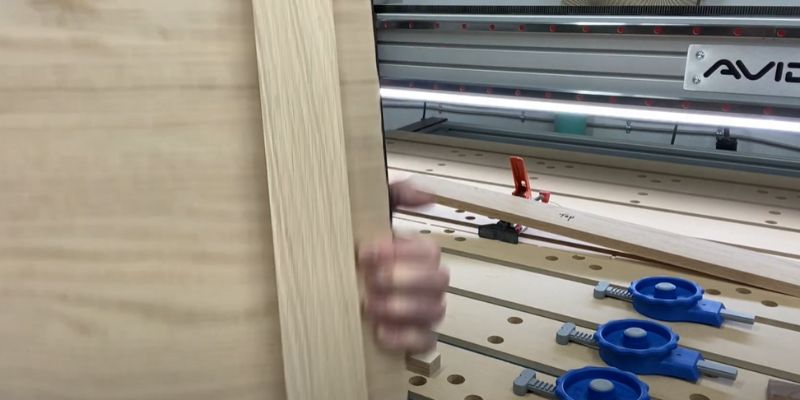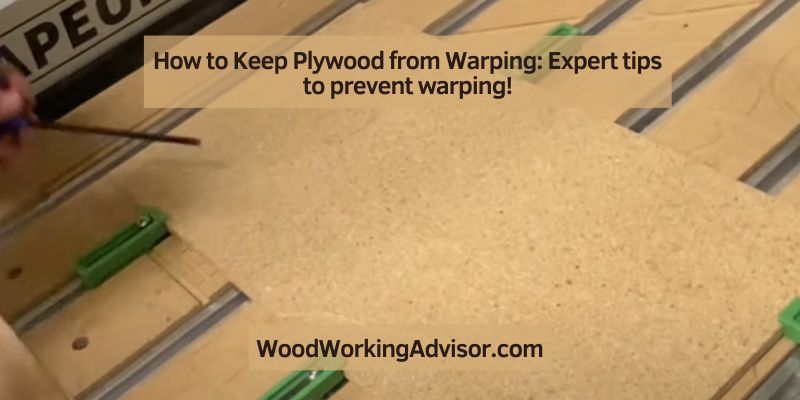To keep plywood from warping, proper storage, sealing the edges, and using a suitable finish can be effective measures. Warped plywood can be a frustrating issue, causing difficulties in construction projects.
Plywood is made up of layers of thin wood veneers bonded together, and its vulnerability to warping is mainly due to changes in moisture content. One of the essential steps to prevent warping is proper storage, which involves keeping the plywood in a dry and well-ventilated area, away from direct sunlight and moisture.
Sealing the edges of the plywood using a wood sealer or primer can help in reducing moisture absorption. Additionally, applying a suitable finish like paint or varnish can provide a protective layer, preventing moisture from seeping into the wood. By following these steps, you can ensure that your plywood remains sturdy and free from warping.
Understanding Plywood Warping
Plywood warping can be a frustrating problem when working with this versatile material. It can negatively impact the quality and integrity of your projects, leading to issues such as uneven surfaces and compromised structural stability. To prevent plywood warping, it is crucial to understand the causes behind this phenomenon and the common types of warping that can occur.
What Causes Plywood Warping?
Plywood warping can be attributed to several factors, including:
- Inherent moisture content imbalances: Plywood consists of layers of stacked veneers bonded together using adhesives. If there is a significant difference in moisture content between the plies, warping can occur as the wood adjusts to its environment. This is particularly true in humid or dry conditions.
- Uneven drying or curing: Improper drying or curing processes during the plywood manufacturing can lead to internal stresses within the wood, ultimately resulting in warping.
- Poor storage conditions: Plywood should be stored in a dry and well-ventilated area. Exposure to excessive moisture, humidity, or temperature fluctuations can cause the plywood to distort and warp over time.

Common Types Of Plywood Warping
Various types of plywood warping can occur, such as:
- Bow: A bow or single-curved warp is characterized by the plywood forming a curve along its length. This typically happens due to an imbalance in moisture content or the presence of internal stresses.
- Cup: Cupping is when the plywood develops a concave or convex shape across its width. This can be caused by differences in moisture content between the face and back veneers or exposure to moisture on one side.
- Twist: Plywood twisting occurs when opposite corners of the board are not level, causing diagonal deformation. This type of warping can be caused by moisture exposure, uneven drying, or improper storage.
| Type of Warping | Description |
|---|---|
| Bow | Curved shape along the length of the plywood |
| Cup | Concave or convex shape across the width of the plywood |
| Twist | Diagonal deformation with opposite corners not level |
Understanding the causes and types of plywood warping is the first step in minimizing or preventing this issue. By implementing appropriate storage, ensuring balanced moisture content, and using proper drying techniques, you can significantly reduce the risk of warping and ensure the longevity and aesthetic appeal of your plywood projects.
Preventing Plywood Warping
Warping, or bowing, is a common issue that can affect plywood, causing frustration and potential setbacks in your projects. However, with the right knowledge and precautions, you can prevent plywood from warping and ensure its stability. In this article, we will explore three key strategies for preventing plywood warping: choosing the right type of plywood, proper storage and handling, and protecting plywood from moisture.
Choosing The Right Type Of Plywood
When it comes to preventing plywood warping, selecting the appropriate type of plywood is crucial. Not all plywood is created equal, and certain types are more resistant to warping than others. Here are a few factors to consider:
- Grade: Opt for high-grade plywood, such as A or B grade, as it tends to have fewer imperfections and is less prone to warping.
- Core Material: Choose plywood with a stable and smooth core material, such as hardwood, as it can help improve the overall stability and reduce the risk of warping.
- Thickness: Thicker plywood tends to be more resistant to warping, as it offers greater rigidity. For projects where warping is a concern, consider using thicker plywood.
Proper Storage And Handling
Proper storage and handling play a vital role in preventing plywood warping. Plywood is sensitive to changes in moisture content, temperature, and humidity, so it’s essential to take the following precautions:
- Store plywood flat: Ensure plywood sheets are stored flat and not leaning against walls or other objects. This helps distribute the weight evenly and minimizes the risk of warping.
- Keep plywood dry: Avoid exposing plywood to excessive moisture or wet conditions. If the plywood becomes damp, allow it to dry thoroughly before use.
- Protect from direct sunlight: Prolonged exposure to direct sunlight can lead to uneven moisture content and warping. Store plywood in a shaded area to minimize this risk.
- Handle with care: When moving plywood sheets, do so with caution and avoid placing excessive pressure on vulnerable areas, such as the corners or edges, which can lead to deformation.
Protecting Plywood From Moisture
Moisture is one of the primary culprits behind plywood warping. Therefore, it’s essential to effectively protect plywood from moisture. Consider the following preventive measures:
- Seal the edges: Apply a moisture-resistant sealant, such as polyurethane, to the ends and edges of plywood sheets to reduce moisture absorption.
- Apply a finish: Finishing the entire surface of plywood with a protective coat, such as paint or varnish, acts as a barrier against moisture penetration.
- Elevate from the ground: When using plywood outdoors or in areas with high humidity, ensure it is elevated from the ground using supports or pallets to prevent moisture absorption from below.
- Monitor humidity levels: Use a hygrometer to monitor the humidity levels in your storage area or project site. Maintaining ideal humidity conditions, typically between 40% and 50%, can help prevent warping.
By following these tips for preventing plywood warping, you can ensure the longevity and stability of your projects. Remember, the proper selection, storage, and protection of plywood are key to keeping it straight and free from warping.
Techniques For Reducing Plywood Warping
Warping is a common issue that plagues plywood, causing it to distort and potentially compromise the structural integrity of your project. To prevent this, it’s important to implement proper techniques. In this article, we will explore four effective methods that can help keep plywood from warping: sealing the edges, applying finish to both sides, using bracing techniques, and using proper fasteners.
Sealing The Edges Of Plywood
One of the key steps in preventing plywood warping is to seal the edges. This creates a barrier that helps minimize moisture absorption and subsequent warping. There are various sealants available in the market that can be applied to the edges of the plywood. These sealants effectively seal the porous edges and reduce water penetration. They also provide a smooth finish, making the plywood more aesthetically pleasing in addition to preventing warping.
Applying Finish To Both Sides
Another technique to keep plywood from warping is to apply finish to both sides. This creates a balanced moisture barrier, ensuring the plywood retains its shape and structure. Before applying the finish, it’s crucial to properly sand the plywood to remove any roughness and imperfections. Applying a stain or paint to both sides creates an even protective layer that helps to minimize moisture absorption and potential warping.

Using Bracing Techniques
Bracing is an effective method for reducing plywood warping. By adding additional support using braces or reinforcements, you can limit the movement and potential warping of the plywood. There are different types of bracing techniques that you can utilize, such as adding cross braces, diagonal braces, or corner blocks. These techniques help distribute the load evenly across the plywood, minimizing the chances of warping due to excessive stress or uneven weight distribution.
Using Proper Fasteners
The type and quality of fasteners play a crucial role in preventing plywood warping. It’s essential to use the right size and type of fasteners that can securely hold the plywood together without causing undue stress or warping. Additionally, spacing the fasteners properly ensures even distribution of pressure, reducing the likelihood of warping. Using screws instead of nails can also provide better holding power and minimize the chances of plywood warping.
By following these techniques – sealing the edges, applying finish to both sides, using bracing techniques, and using proper fasteners – you can significantly reduce the risk of plywood warping. Investing a little extra time and effort in implementing these preventive measures will result in a more durable, long-lasting plywood project.
Frequently Asked Questions For How To Keep Plywood From Warping
How Can I Prevent Plywood From Warping?
To prevent plywood from warping, make sure to store it properly in a dry area with even air circulation. Avoid exposing it to high humidity or moisture. Apply a sealant or finish to both sides of the plywood to create a barrier against moisture.
Additionally, using proper fasteners and spacing them adequately can help reduce warping.
Can I Use A Water-resistant Sealant To Prevent Plywood Warping?
Yes, using a water-resistant sealant on plywood can help prevent warping. Apply the sealant to both sides of the plywood, ensuring complete coverage. This will create a barrier that will protect the plywood from moisture and minimize the risk of warping.
Is It Necessary To Acclimate Plywood Before Using It?
Acclimating plywood is crucial before using it. Allow the plywood to adapt to the environment in which it will be installed. Store it for a minimum of 48 hours in that space, ensuring proper air circulation. This process helps reduce the likelihood of warping by allowing the plywood to adjust to temperature and humidity conditions.
Can I Minimize Warping By Using Proper Fasteners?
Using proper fasteners can help minimize warping in plywood. Choose fasteners specifically designed for plywood, such as ring shank nails or screws, as they provide better holding power. Additionally, make sure you’re spacing the fasteners adequately along the edges and throughout the plywood sheet to distribute the stress evenly and reduce the chance of warping.
Conclusion
To conclude, preventing plywood from warping requires a proactive approach that includes proper storage, preparation, and installation. By ensuring the plywood is stored in a dry environment and sealing the edges before use, you can minimize the risk of warping.
Additionally, taking precautions such as securing the plywood with screws at regular intervals and using supports can further enhance its stability. Following these guidelines will help you maintain the integrity of your plywood and make the most out of its longevity.



3 thoughts on “How to Keep Plywood from Warping: Expert tips to prevent warping!”